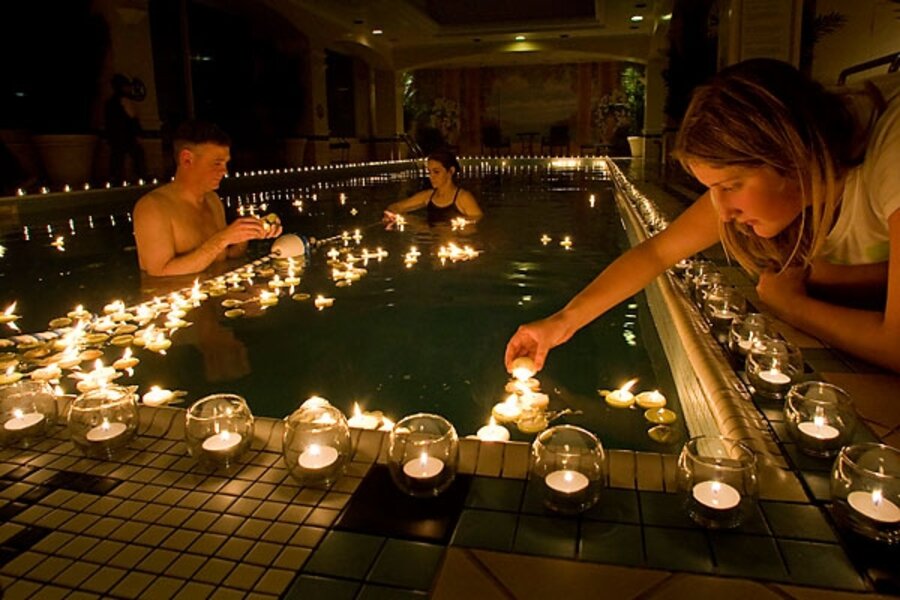Does lighting candles for Earth Hour defeat the purpose?
Loading...
Saturday, March 28, is Earth Hour, an annual international event organized by WWF to raise awareness of climate change in which participants switch off all their lights for one hour, beginning at 8:30 p.m. local time.
The first Earth Hour took place in Sydney in 2007, when 2.2 million million homes and businesses pledged to turn off their lights. The following year, the event went global, with the Golden Gate Bridge, the Coliseum, the Sydney Opera House, and the Coca-Cola billboard in Times Square all going dark. That year, 50 million people in more than 370 cities and towns worldwide switched off their lights.
This year, 2,848 cities, towns, and municipalities are joining the eco-blackout. The event's organizers say that they are shooting for 1 billion people to participate.
And during Earth Hour, what will most participants use for illumination? Candles. The Earth Hour website is filled with announcements – from New Zealand to Hong Kong to Serbia – of restaurants hosting candlelit dinners and clubs holding candlelit acoustic concerts, along with lots of tips on what to do at home during the electricity-free hour, which includes taking a candlelit bath or playing board games by candlelight.
All these burning wicks raise the question: Are the emissions from these candles worse for the climate than simply leaving the lights on? After all, candles emit carbon dioxide too.
The answer: It depends on what kind of candles you use, how many of them you burn, and where you get your electricity from.
Most candles are made of paraffin, a heavy hydrocarbon derived from crude oil. Burning a paraffin candle for one hour will release about 10 grams of carbon dioxide.
As Australian blogger Enoch the Red pointed out after last year's Earth Hour that an average Australian who tries to replace all the light produced by an incandescent bulb with light cast by parrifin candles will result in about 10 times the greenhouse emissions.
But of course most of us aren't going to burn 40 candles for every bulb we leave off. The idea here is to make our cities and towns go dark for an hour, not to create a major fire hazard.
So what if you just replace a single paraffin candle with a single bulb? This was the question Zeke Hausfather, the executive vice president of energy science for Climate Culture, an online carbon measurement and reduction utility, tried to answer for the Bright Green Blog.
In an email, Mr. Hausfather noted that emissions vary widely, depending on where you live. In California, which has some of the country's lowest emissions per kilowatt-hour of electricity, running a 60-watt incandescent bulb for an hour would emit about 24 grams of CO2. In Kansas, which has some of the highest emissions, it would emit almost 60 grams.
Therefore, Hausfather concludes "using a candle instead of an incandescent bulb unambiguously reduces your carbon emissions."
But what about more efficient bulbs? After all, if you're bothering to participate in a global-warming-consciousness-raising event, there's a good chance you've already swapped out your incandescents for CFLs, right?
Depending on where you live and what wattage bulb you use, lighting a candle instead of a CFL could result in a net increase of CO2 emissions. In California, a CFL will emit about 5 grams per hour. In Kansas, it's almost 13 grams.
Hausfather provides this handy map. The red areas represent net emission increases for those who burn a candle instead of a CFL. The green areas represent net reductions.
Hausfather points out that, given the low penetration of CFLs and the fact that many commercial buildings will not be replacing the light with anything during the hour, it's incontrovertible that Earth Hour will result in a net carbon reduction, even with all the candles.
But of course you don't have to burn paraffin candles. Beeswax and soy candles are mostly carbon-neutral because any carbon they release by burning was only recently absorbed by plants from the atmosphere. The carbon in paraffin, by contrast, has been sitting in the ground for hundreds of millions of years.
Earth Hour's organizers get this, of course, and they advise people not to burn paraffin candles for the event. For the sake of the climate, let's hope the participants get it, too.





